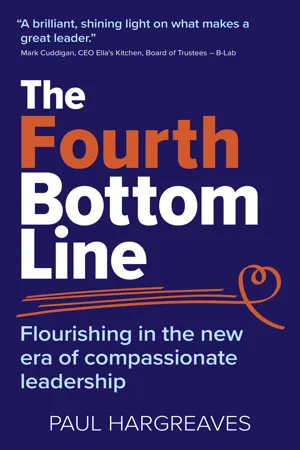Dictionary definition:‘Conscious of one’s own feelings, character, etc.’Collins English Dictionary
Quotes:‘Of all deceivers fear most yourself!’Søren Kierkegaard, Danish philosopher
‘Everything that irritates us about others can lead us to an understanding of ourselves.’Carl Jung, Swiss psychoanalyst
‘Self-awareness is our capacity to stand apart from ourselves and examine our thinking, our motives, our history, our scripts, our actions, and our habits and tendencies.’Stephen Covey, American educator and businessperson
‘Self-awareness is not self-centeredness, and spirituality is not narcissism. “Know thyself” is not a narcissistic pursuit.’Marianne Williamson, American politician and activist

The Fourth Bottom Line
Flourishing in the era of compassionate leadership
- 288 pages
- English
- ePUB (mobile friendly)
- Available on iOS & Android
About this book
Are you looking for a more compassionate, caring and loving way to lead?
Do you want to be a leader that makes a meaningful difference, who opposes injustice and strives to make the world a better place?
In this unique, empowering and inspiring guide, Business Leader and BCorp Ambassador Paul Hargreaves challenges you to banish outdated, paternalistic, 'command and control' leadership and instead embrace the positive, proactive and purpose-led styles that have the power to energise, empower, elevate and change the world.
Using an enlightening and thought-provoking mix of stories, quotes and case-studies, Paul will guide you on a journey through 50 essential leadership qualities. Day by day he'll equip you with ingenious ideas, inspiration and the mindset you need to become a leader who:
- Nurtures, supports and cherishes the planet as well as your people.
- Releases love, compassion and care throughout your organisation.
- Challenges the status quo and is a catalyst for positive change.
- Uses empathy, trust and mutual respect to drive success and encourage the best in others.
By becoming a genuinely dynamic and human leader who's driven by principle, purpose and passion, you'll make a more profound impact on your business and the world as you create a legacy to be proud of.
Frequently asked questions
- Essential is ideal for learners and professionals who enjoy exploring a wide range of subjects. Access the Essential Library with 800,000+ trusted titles and best-sellers across business, personal growth, and the humanities. Includes unlimited reading time and Standard Read Aloud voice.
- Complete: Perfect for advanced learners and researchers needing full, unrestricted access. Unlock 1.4M+ books across hundreds of subjects, including academic and specialized titles. The Complete Plan also includes advanced features like Premium Read Aloud and Research Assistant.
Please note we cannot support devices running on iOS 13 and Android 7 or earlier. Learn more about using the app.
Information
DAY 1 » Self-aware
DAY 2 » Humble
Dictionary definition:‘Marked by meekness or modesty in behaviour, attitude, or spirit; not arrogant or prideful.’Free Dictionary
Quotes:‘Humility is not thinking less of yourself, it’s thinking of yourself less.’C. S. Lewis, British writer and theologian
‘It would be very egotistical of me to say how I would like to be remembered. I’d leave that entirely to South Africans. I would just like a simple stone on which is written “Mandela”.’Nelson Mandela, South African anti-apartheid revolutionary
‘Humility is like underwear; essential, but indecent if it shows.’Helen Nielsen, American script writer
‘Humility is throwing oneself away in complete concentration on something or someone else.’Madeleine L’Engle, American author
Insights
Table of contents
- Cover
- Blurbs
- Title Page
- Contents
- Copyright
- Dedication
- Foreword – Sujith Ravindran, Founder, Global Foundation for BEING Leadership
- Introduction
- DAY 1 » Self-aware
- DAY 2 » Humble
- DAY 3 » Forgiving
- DAY 4 » Empathetic
- DAY 5 » Gracious
- DAY 6 » Solitary
- DAY 7 » Playful
- DAY 8 » Servant-like
- DAY 9 » Thankful
- DAY 10 » Kind
- DAY 11 » Generous
- DAY 12 » Creative
- DAY 13 » Content
- DAY 14 » Compassionate
- DAY 15 » Courageous
- DAY 16 » Self-sacrificial
- DAY 17 » Joyful
- DAY 18 » Vulnerable
- DAY 19 » Integrous
- DAY 20 » Flowing
- DAY 21 » Inclusive
- DAY 22 » Anonymous
- DAY 23 » Available
- DAY 24 » Patient
- DAY 25 » Hospitable
- DAY 26 » Silent
- DAY 27 » Resilient
- DAY 28 » Collaborative
- DAY 29 » Interdependent
- DAY 30 » Purposeful
- DAY 31 » Loyal
- DAY 32 » Connected
- DAY 33 » Peace-loving
- DAY 34 » Gentle
- DAY 35 » Curious
- DAY 36 » Contrite
- DAY 37 » Protective
- DAY 38 » Intuitive
- DAY 39 » Non-judgmental
- DAY 40 » Self-disciplined
- DAY 41 » Wise
- DAY 42 » Loving
- DAY 43 » Justice-loving
- DAY 44 » Honest
- DAY 45 » Self-caring
- DAY 46 » Friendly
- DAY 47 » Calm
- DAY 48 » Persevering
- DAY 49 » Authentic
- DAY 50 » Good
- Bibliography
- Acknowledgments
- About the Author